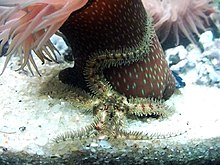Ophiothrix fragilis
| Common brittle star | |
|---|---|
 |
|
| Ophiothrix fragilis | |
| Scientific classification | |
| Kingdom: | Animalia |
| Phylum: | Echinodermata |
| Class: | Ophiuroidea |
| Order: | Ophiurida |
| Family: | Ophiothricidae |
| Genus: | Ophiothrix |
| Species: | O. fragilis |
| Binomial name | |
|
Ophiothrix fragilis Abildgaard, 1789 |
|
| Synonyms | |
|
|
Ophiothrix fragilis is a species of brittle star in the order Ophiurida. It is found around the coasts of western Europe and is known in Britain as the common brittle star.
The common brittle star is extremely variable in colouration, ranging from violet, purple or red to yellowish or pale grey, often spotted with red. The arms are usually white or grey with pink bands. The central disc is about one centimetre in diameter with the five arms being about five times as long. The disc is clothed in five rays of spines radiating from a spiny centre. Between these are five pairs of triangular plates, each pair forming a heart shaped pattern. The slender tapering arms are quite distinct from the disc and are covered with overlapping scales. The dorsal arm plates are naked and have a longitudinal keel. Each arm segment bears seven glassy, toothed spines. The arms are extremely fragile and easily shed, coming away either whole or in pieces.
This species is common around the coasts of Britain and Ireland and in the North Sea. It ranges southwards from the Lofoten Islands and Iceland to the Mediterranean Sea and the Azores, and along the west coast of Africa south to the Cape of Good Hope. It is most common on tide-swept rock and on coarse sediments, preferring hard substrates including sand and shingle. It is often found in empty shells or under stones, from the littoral zone down to 350 metres.
The common brittle star sometimes congregates offshore in vast numbers and as many as two thousand individuals have been recorded in a single square metre. Higher up the shore it normally lives a solitary existence under seaweed or pebbles or in crevices. It moves by jerking a pair of limbs forward and pulling itself along.
The common brittle star is a scavenger, feeding on dead organisms. It is also a suspension feeder, raising an arm and extending the tube feet in order to catch particles floating by. It then passes the food to the mouth with its arms. Its abundance varies according to environmental conditions including temperature and the availability of food. After mild winters, it has been found in very large numbers in the Oosterschelde estuary in the Netherlands.
...
Wikipedia
